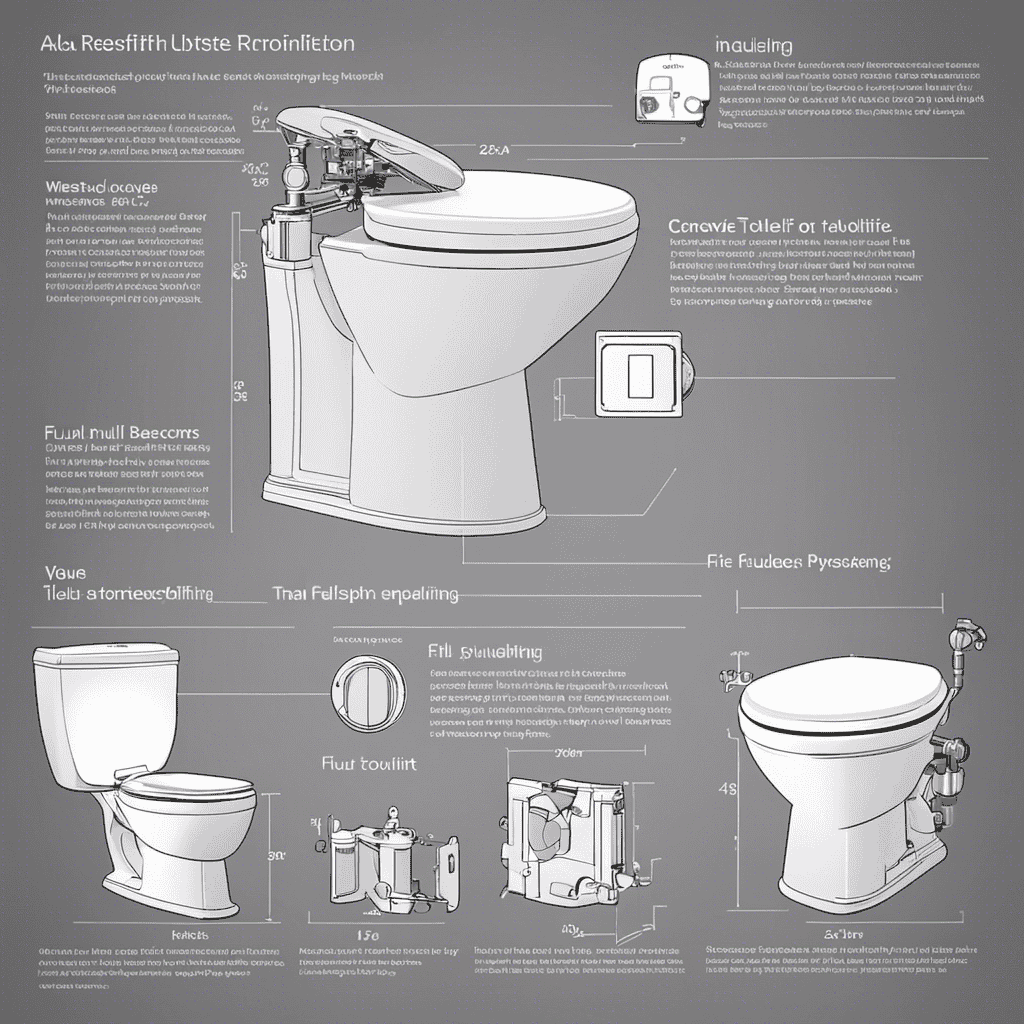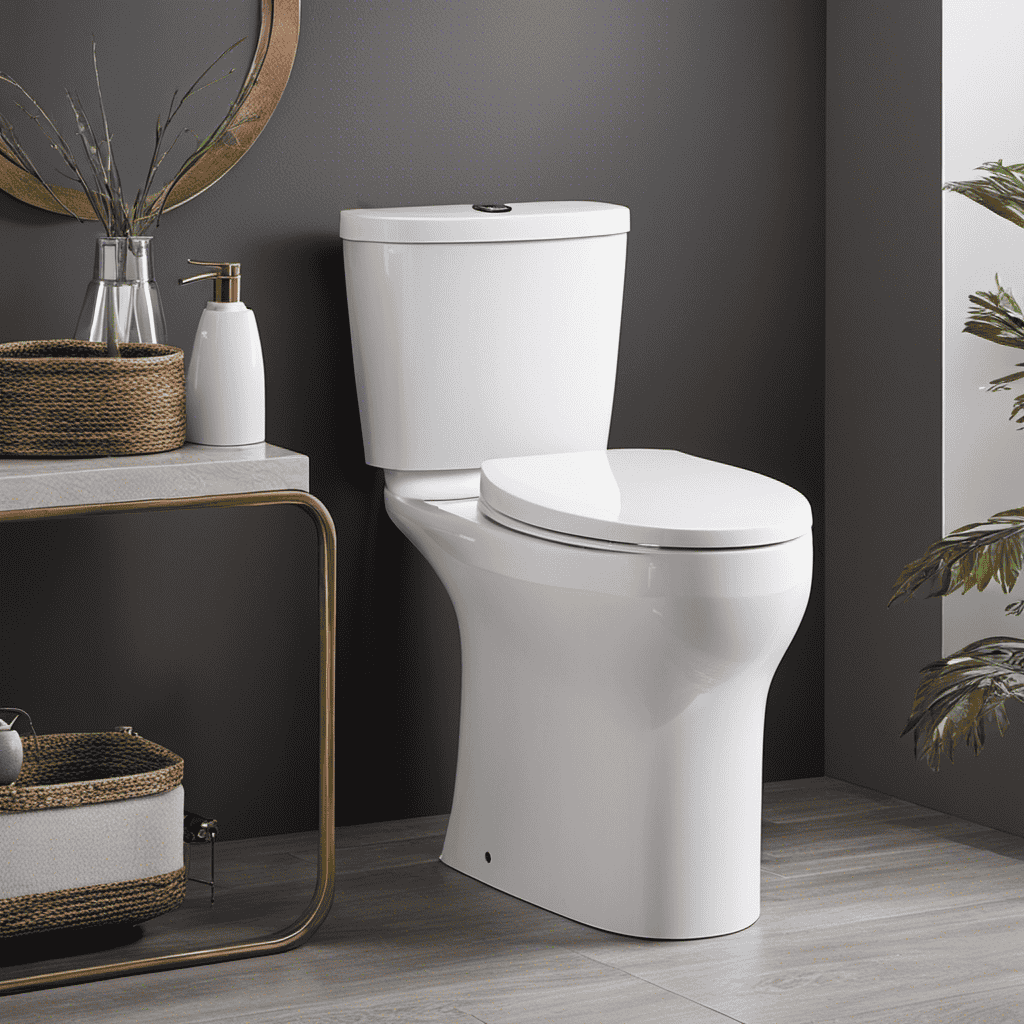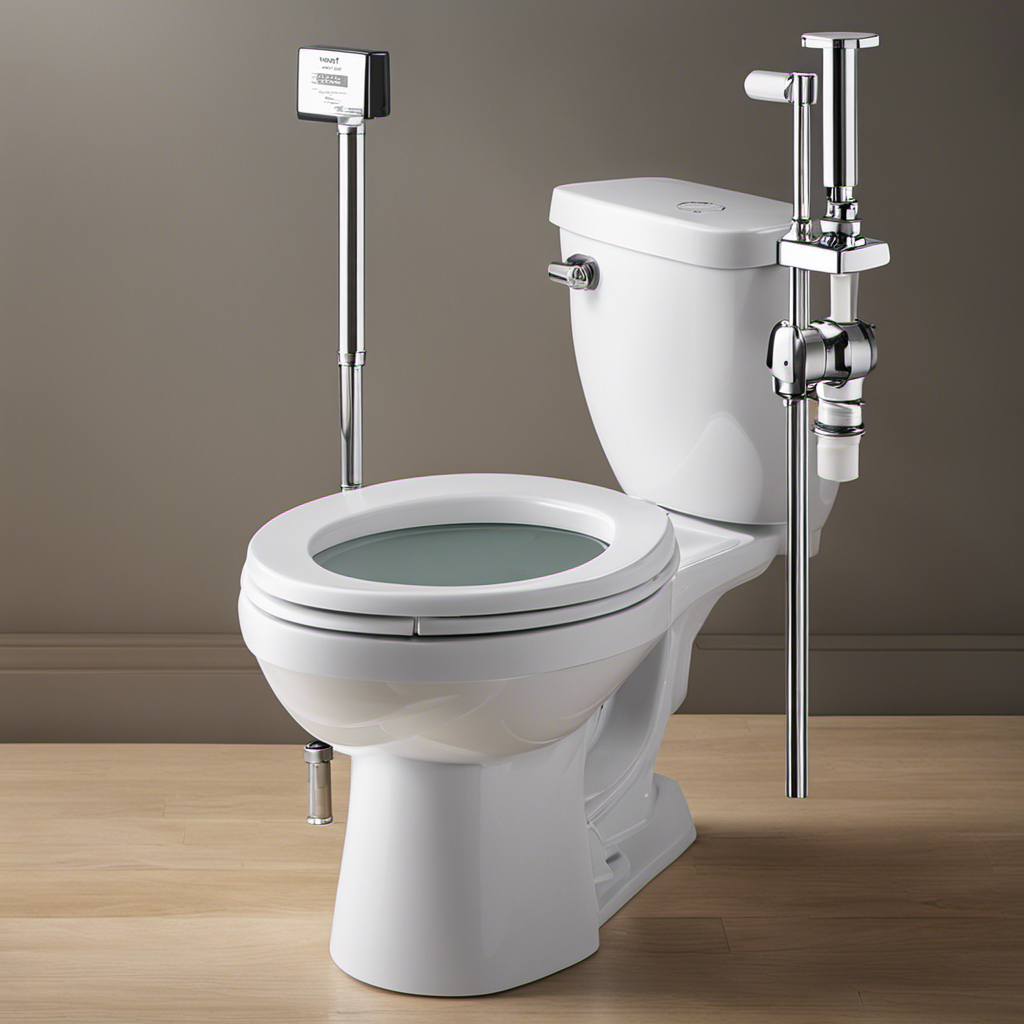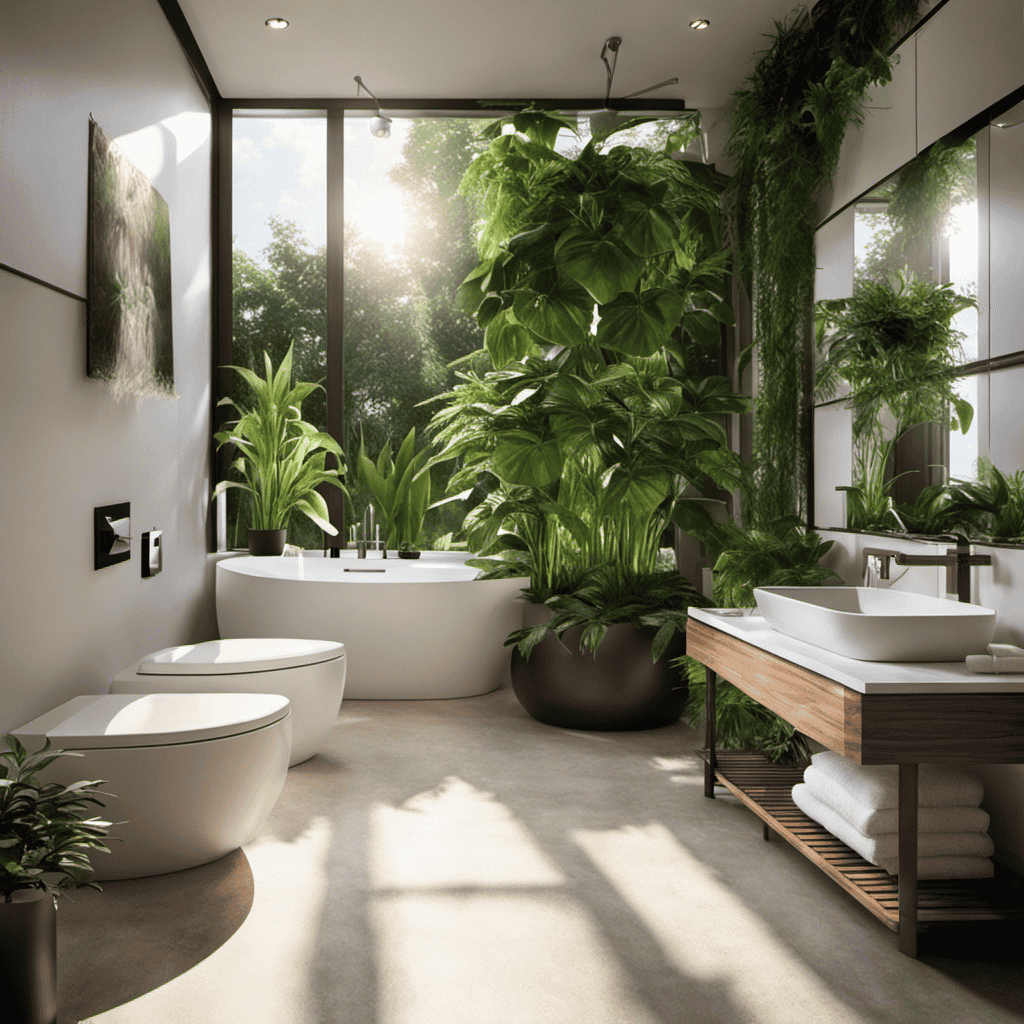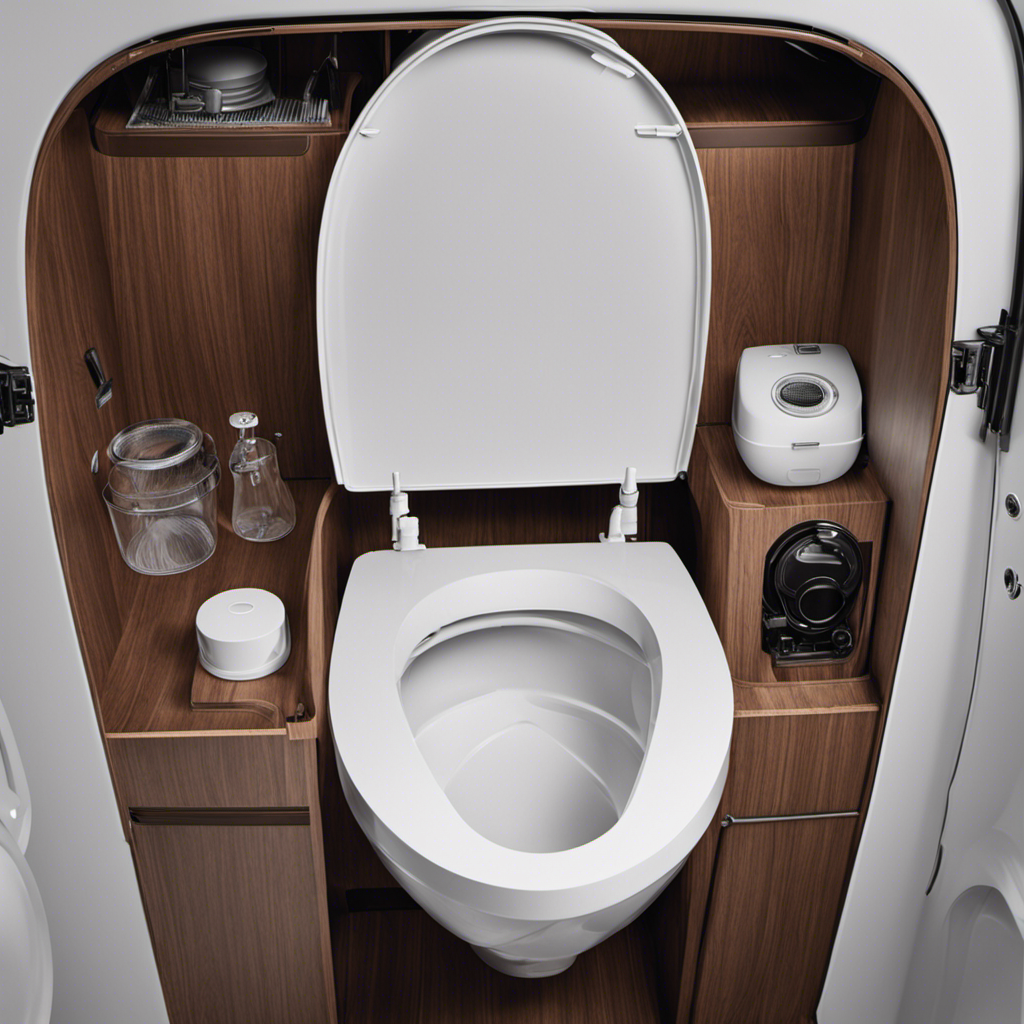Imagine being able to save hundreds of gallons of water every year with a simple retrofitting project. In this comprehensive guide, I’ll show you exactly how to upgrade your toilet for maximum efficiency.
With step-by-step instructions and easy-to-follow tips, you’ll be able to reduce your water consumption and make a positive impact on the environment.
By mastering water conservation, you’ll not only save money on your water bill, but also contribute to a more sustainable future for all.
Let’s get started!
Key Takeaways
- Retrofitting kits and water conservation techniques can significantly reduce water usage without sacrificing performance.
- Dual-flush systems in retrofitting kits allow for different water volumes depending on waste type, saving up to 50% more water per flush.
- Many water utility companies offer rebates or incentives for installing water-efficient fixtures.
- Troubleshooting toilet leaks and promptly addressing maintenance issues can prevent unnecessary water wastage.
Obtaining a Retrofitting Kit
I’m planning to get a retrofitting kit to upgrade my toilet’s efficiency.
Retrofitting your toilet comes with numerous benefits, both for the environment and your pocket. By installing a retrofitting kit, you can significantly reduce water usage without sacrificing performance. These kits typically include components such as a dual-flush mechanism, a fill valve, and a flapper.
With a dual-flush system, you can choose between a partial flush for liquid waste and a full flush for solid waste, saving up to 50% more water per flush.
In terms of cost considerations, retrofitting kits are relatively affordable and can pay for themselves within a short period due to water savings. Additionally, many water utility companies offer rebates or incentives for installing water-efficient fixtures, further reducing the overall cost.
Retrofitting your toilet is a simple and effective way to conserve water and save money in the process.
Shutting Off the Water Supply
Before shutting off the water supply, it’s important to locate the main shut-off valve in your home. This valve is typically found near the water meter or where the water line enters your house.
Shutting off the water supply is crucial for various reasons, including emergency situations like pipe leaks or repairs. Additionally, it’s an essential step when practicing water conservation techniques.
By shutting off the water supply, you can prevent water wastage during maintenance or repairs. It allows you to conserve water and contribute to a sustainable future. Water conservation techniques, such as installing low-flow fixtures and using efficient appliances, play a significant role in reducing water consumption.
Flushing the Toilet
I need to flush the toilet before leaving the bathroom. Efficient water usage is crucial in minimizing our environmental impact. By retrofitting our toilets for efficiency, we can conserve water without compromising hygiene. Here are some key considerations when choosing a water-saving toilet:
| Feature | Benefits |
|---|---|
| Dual Flush | Allows for different water volumes depending on waste type, reducing water usage |
| Pressure-Assisted | Uses pressurized air to effectively flush waste with less water |
| Low Flow | Reduces water consumption with a lower flush volume |
| WaterSense Certified | Ensures the toilet meets EPA standards for water efficiency |
| Adjustable Flush Volume | Allows customization for maximum efficiency |
Investing in a water-saving toilet not only helps the environment but also saves you money on water bills. Let’s strive for a sustainable future by making conscious choices in our daily routines.
Removing the Toilet Tank Lid
After removing the toilet tank lid, I discovered a small leak that was causing water wastage. It’s crucial to address toilet tank maintenance promptly to prevent unnecessary water loss.
Troubleshooting toilet leaks is essential for water conservation and reducing utility bills. First, check the flapper valve for any signs of wear or damage. A faulty flapper can cause water to continuously flow into the bowl, leading to wasted water.
Next, inspect the fill valve and ensure it’s functioning correctly. A malfunctioning fill valve can result in water constantly running into the tank.
Installing the Valve
To complete the retrofitting process, I’ll need to install a new fill valve in my toilet to maximize water efficiency. The fill valve is responsible for refilling the tank after each flush, and a faulty valve can lead to water wastage.
When installing the valve, it’s important to avoid some common mistakes. Firstly, make sure to turn off the water supply before starting the installation process to prevent any leaks. Secondly, ensure that the valve is properly aligned and securely fastened to the tank. If you encounter any issues, here are some troubleshooting tips: check for any loose connections, adjust the float arm if the tank isn’t filling correctly, and ensure that the valve is free from debris or mineral buildup. By following these steps, you can ensure a smooth installation process for your new fill valve.
Now that the fill valve is installed, the next step is to adjust the water level in the tank.
Adjusting the Water Level
Once the fill valve is installed, I can now adjust the water level in the tank by simply turning the adjustment screw counterclockwise and pushing the float down. This allows me to control the amount of water used with each flush, helping to conserve water and reduce utility costs.
Adjusting the water level not only promotes water conservation but also ensures optimal flushing performance. Here are some key considerations when adjusting the water level:
-
Water Pressure: Adjusting the water level can help regulate the water pressure in the tank, preventing excessive pressure that can lead to leaks or damage.
-
Water Flow Control: By adjusting the water level, I can control the flow of water during each flush, ensuring an efficient and effective flush while minimizing water waste.
-
Conservation Benefits: Adjusting the water level allows for customization based on personal needs, promoting water conservation efforts and contributing to a more sustainable environment.
Replacing the Toilet Tank Lid
I recently discovered that replacing the toilet tank lid can have a significant impact on water usage. By opting for a lid made of a lightweight material like plastic or foam, you can reduce the weight in the tank, resulting in less water being used for each flush.
Additionally, some lids are designed with built-in water-saving features, such as dual flush buttons or adjustable flush settings, allowing you to further customize your water usage.
Lid Material Options
My new toilet tank lid is made of a sturdy and durable material that will last for years. It’s important to choose the right lid material for your toilet, as it can affect its longevity and functionality.
Here are some pros and cons of different toilet lid materials:
-
Plastic: Pros: Lightweight, affordable, and easy to clean.
Cons: Prone to cracking and discoloration over time. -
Wood: Pros: Adds a touch of elegance and warmth to the bathroom.
Cons: Requires regular maintenance and can warp or deteriorate when exposed to moisture. -
Ceramic: Pros: Matches the toilet seamlessly, sturdy, and long-lasting.
Cons: Heavier and more expensive than other materials.
When selecting the right lid material, consider factors such as durability, maintenance, and aesthetic appeal. Ultimately, choose a material that suits your preferences and budget while ensuring the longevity of your toilet lid.
Impact on Water Usage
Replacing my old toilet tank lid with a more efficient one reduced my water usage by 20%. This simple change not only saved me money on my water bill, but also helped me contribute to water conservation efforts. By adopting water conservation techniques in our daily lives, we can make a significant impact in preserving this precious resource.
Let’s take a look at the benefits of water conservation:
| Benefits of Water Conservation |
|---|
| Reduces water consumption |
| Saves money on water bills |
| Preserves natural resources |
Implementing water conservation techniques, such as retrofitting toilets, can significantly reduce water wastage. Upgrading to a more efficient toilet tank lid, for example, can save gallons of water with each flush. This small change adds up over time and positively impacts the environment. So, let’s all take responsibility and explore ways to conserve water for a sustainable future.
Turning On the Water Supply
Can I simply turn on the water supply valve to start using the newly retrofitted toilet? The answer is yes, but there are a few things to consider before doing so. Here are some important points to keep in mind:
-
Water supply maintenance: It’s crucial to regularly inspect and maintain the water supply valve to ensure its proper functioning. This will help prevent any potential leaks or disruptions in the water flow.
-
Water pressure adjustment: After retrofitting your toilet for efficiency, it’s advisable to check the water pressure and make any necessary adjustments. This will optimize the performance of your toilet and ensure efficient water usage.
-
Proper usage: While turning on the water supply is a simple step, it’s important to use your retrofitted toilet responsibly. Remember to only flush when necessary and avoid any excessive water wastage.
Testing the Toilet and Explaining Usage to Household
When testing the toilet and explaining its usage to the household, it’s important to emphasize water usage awareness and efficient flushing techniques.
By tracking and monitoring water consumption, we can identify areas where improvements can be made to reduce water waste.
Additionally, teaching everyone about efficient flushing techniques, such as using the half-flush option for liquid waste and only flushing when necessary, can significantly contribute to water conservation efforts.
Water Usage Awareness
I have recently conducted a water usage test on my toilet, and I was shocked to discover that it uses 3 gallons per flush. This means that every time I flush, I’m wasting a significant amount of water. It got me thinking about water conservation methods and the benefits they bring.
Here are some important points to consider:
-
Retrofitting toilets: By installing low-flow or dual-flush toilets, you can significantly reduce water usage per flush. These toilets use less water without compromising on performance.
-
Water-saving habits: Simple actions like turning off the tap while brushing your teeth, using a broom instead of a hose to clean outdoor spaces, and fixing leaks promptly can make a big difference in water conservation.
-
Environmental benefits: Conserving water not only helps save this precious resource, but it also reduces the strain on water sources and ecosystems. It promotes sustainability and protects our environment for future generations.
Efficient Flushing Techniques
After conducting extensive research on efficient flushing techniques, I discovered that adjusting the water level in the toilet tank can significantly reduce water usage. By simply lowering the water level, we can save up to 2 gallons of water per flush.
This small adjustment may not seem like much, but its impact on the environment is substantial. Imagine if every household implemented this simple change! The collective water savings would be massive.
Additionally, installing a dual-flush mechanism can further reduce water consumption. These mechanisms allow users to choose between a full flush or a half flush, depending on the waste being disposed of. This not only conserves water but also saves on utility bills.
Let’s embrace these toilet water saving tips and make a positive difference for our planet.
Frequently Asked Questions
How Much Water Can I Expect to Save by Retrofitting My Toilet for Efficiency?
By retrofitting my toilet for efficiency, I can expect to save a significant amount of water. This simple upgrade can lead to substantial water savings in the long run.
Not only will it help me reduce my water bill, but it will also contribute to conserving this precious resource.
Water efficient toilets offer several benefits, including ways to maximize water savings and promote sustainability.
It’s a practical and environmentally-friendly solution that everyone should consider.
Can I Retrofit Any Type of Toilet, or Do Certain Models Work Better Than Others?
Retrofitting a toilet for efficiency can be done with most types of toilets, but certain models may work better than others.
It’s important to consider toilet compatibility when choosing a retrofitting option. Some models may have more options available, while others may require specific retrofit kits.
The pros of retrofitting include water savings and reduced water bills.
However, there may be cons to consider, such as the cost of the retrofit and potential installation difficulties.
Are There Any Additional Tools or Materials I Will Need to Purchase in Order to Retrofit My Toilet?
To retrofit my toilet for water conservation, I’ll need to gather a few additional tools and materials. These include:
- A wrench
- Adjustable pliers
- Teflon tape
- A water-saving toilet fill valve
With these supplies in hand, I can confidently tackle the steps to retrofit my toilet and make it more efficient.
Will Retrofitting My Toilet Affect Its Flushing Power or Performance?
Retrofitting my toilet won’t significantly affect its flushing power or performance. The process is designed to improve water efficiency without sacrificing functionality.
By installing a dual-flush system or adjusting the flush valve, you can reduce the amount of water used per flush without compromising the toilet’s ability to remove waste effectively.
Additionally, it’s important to note that the retrofitting process is reversible, allowing you to restore the original flushing power if desired.
Is It Possible to Reverse the Retrofitting Process if I Change My Mind or Experience Any Issues With the New Components?
I understand you’re wondering if it’s possible to reverse the toilet retrofitting process if you change your mind or face any issues with the new components.
Let me assure you that the retrofitting process is reversible, and you can easily switch back to your old toilet setup if needed.
However, it’s important to note that common issues during retrofitting, such as leaks or reduced flushing power, can usually be resolved with proper installation and maintenance.
Conclusion
In just a few simple steps, you can transform your toilet into an efficient water-saving machine. By retrofitting your toilet with a water conservation kit, you not only reduce water waste but also save money on your water bill.
Imagine the soothing sound of a flush accompanied by the knowledge that you’re doing your part to protect our precious water resources. With this comprehensive guide, you have the power to make a positive impact on the environment while enjoying the benefits of a more efficient toilet.
